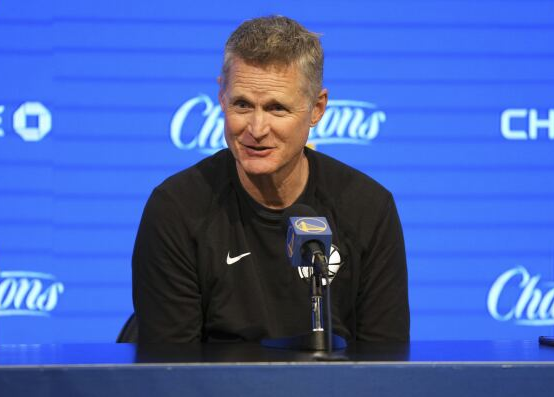Lindy Waters III, now a reserve guard for the Golden State Warriors, exemplifies the challenges of adapting to the unpredictable nature of professional basketball, especially in a team experimenting with a unique 12-man rotation. This approach emphasizes flexibility over fixed roles, disrupting routines many players rely on for consistency. Waters’ anecdote about his disrupted pregame meal—chicken and rice being unavailable—reflects a broader theme of adjusting to change in a dynamic environment.
The Warriors’ emphasis this season is on adaptability. Outside of core players like Stephen Curry and Draymond Green, roles are fluid. The team’s depth and Steve Kerr’s experimental rotation strategy mean players like Waters must be ready for fluctuating minutes and assignments. This unpredictability can be unsettling but aligns with the Warriors’ strategy to maximize their roster’s potential and preserve energy for key players.

For Waters, who joined Golden State after time with the Oklahoma City Thunder and stints in the G League, adapting to this fluidity is both a challenge and an opportunity. His ability to step into various roles as needed will be crucial, especially in a team striving for another deep playoff run. His story underscores the unique challenges bench players face in maintaining readiness and mental sharpness amid shifting roles.
Golden State Warriors’ decision to deploy a 12-man rotation this season highlights their commitment to innovation and resourcefulness in a league dominated by rigid systems. Lindy Waters III, who has worked his way up from G League stints to a role on the Warriors’ bench, embodies the challenges and opportunities inherent in such an experimental strategy.
The unconventional approach aims to leverage the team’s depth to maintain intensity throughout games and conserve the energy of stars like Stephen Curry and Draymond Green for critical moments. However, this fluid system requires players to adapt to inconsistent playing time, shifting roles, and even minor disruptions to their routines—something Waters highlighted in a lighthearted comment about missing his usual pregame chicken and rice.
For players like Waters, adaptability and readiness are paramount. The Warriors’ system rewards versatility and the ability to contribute in unpredictable situations, which Waters has shown a capacity for throughout his career. As Golden State seeks to extend its championship window, the success of this rotation could hinge on how well players embrace their roles, however variable, within this dynamic framework.
Steve Kerr’s 12-man rotation experiment with the Golden State Warriors this season has been a bold approach, and so far, the results have been promising. Despite the novelty of this strategy—which has never been attempted over a full season—Kerr is seeing a tangible shift in the Warriors’ performance. The team’s defense has drastically improved, leaping from 15th in the league last year to 4th currently, and their bench is delivering an impressive 55 points per game, leading the league in bench production.
The key philosophy behind Kerr’s rotation is to maximize effort in shorter, more intense stints. By giving more players the chance to play regularly, Kerr hopes to keep the intensity high and the energy levels up. This fresh approach is particularly beneficial for defensive focus and ensuring that players like Stephen Curry and Draymond Green don’t burn out during the season.
One player whose experience reflects the challenges of this unpredictable rotation is Lindy Waters III, who was an afterthought heading into camp but has earned valuable minutes, averaging 15.4 minutes per game. He has played various roles, sometimes starting, sometimes receiving DNPs (Did Not Play). Despite the inconsistency in his playing time, Waters has embraced the opportunity, contributing with scoring, defense, and energy, while keeping a positive outlook. His willingness to adapt to the rotation’s fluidity has helped him carve out a role despite the uncertainty.
The team’s fluid rotation, however, brings its own challenges. Players like Waters could face frustration from inconsistency, given the frequent changes in who plays, when, and how much. Yet, Waters has voiced his gratitude for simply being part of the Warriors’ system, acknowledging the challenge and joy that comes with being in such an unpredictable environment.
This flexible, experimental approach by Kerr is still a work in progress, and while it may shrink depending on injuries or trades, for now, the Warriors are benefiting from a fresh dynamic. The key will be whether they can maintain this system’s success and avoid frustration or burnout as the season continues.
The Golden State Warriors’ decision to deploy a 12-man rotation this season has sparked significant conversation, but it’s also been fruitful so far. Players like Lindy Waters III have expressed how the unpredictable nature of the rotation mirrors their early careers, where their roles were often uncertain and they had to stay ready at a moment’s notice. Waters, particularly, has embraced this sporadic role, which involves jumping into games unexpectedly, while also staying prepared through his past experiences with two-way contracts and last-minute call-ups. Similarly, Gary Payton II emphasized the importance of being ready for any situation, trusting that Coach Kerr will give opportunities if players prove themselves worthy.
This rotation shift comes after the Warriors’ busy offseason, where roster changes, including the loss of Klay Thompson and a subsequent trade for Buddy Hield and Kyle Anderson, created a deeper roster. The Warriors didn’t set out with a 12-man rotation in mind but, according to General Manager Mike Dunleavy Jr., the surplus of talent became an issue when they found themselves with too many good players to ignore. While they initially aimed to acquire a third star to bolster their title chances, the unexpected development of their young players like Kuminga, Moody, and Podziemski made a shorter rotation less feasible.
Steve Kerr’s coaching philosophy, heavily influenced by Phil Jackson, values the depth of the roster. This philosophy stems from Kerr’s early experiences with Jackson’s Chicago Bulls, where using all players at various moments helped create unity and a sense of shared purpose. The Warriors have embraced this model, focusing on “strength in numbers,” with each player expected to contribute when called upon. This approach remains flexible, with the understanding that the Warriors may make moves to refine the roster or address challenges as the season progresses.
The key for the Warriors this season will be managing the depth without causing internal friction. As of now, players seem to be accepting their roles, with no complaints about their minutes, and team chemistry remains high. However, whether this strategy will pay off in the long run, especially when it comes to competing against teams like the Nuggets, Suns, or Celtics, remains to be seen. The Warriors may eventually trim the rotation or make roster moves to optimize their chances for a title run. However, Kerr and Dunleavy are taking things one step at a time, enjoying the challenge of leading this newly-configured team.
For more details on the Warriors’ evolving rotation and the challenges of managing a deep roster, check out coverage on The Athletic and other sports news outlets.



